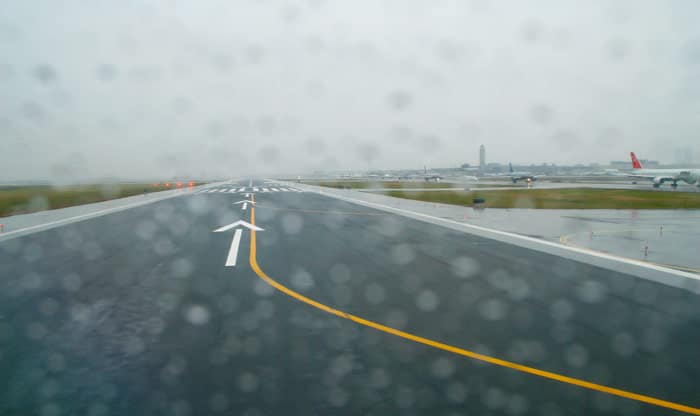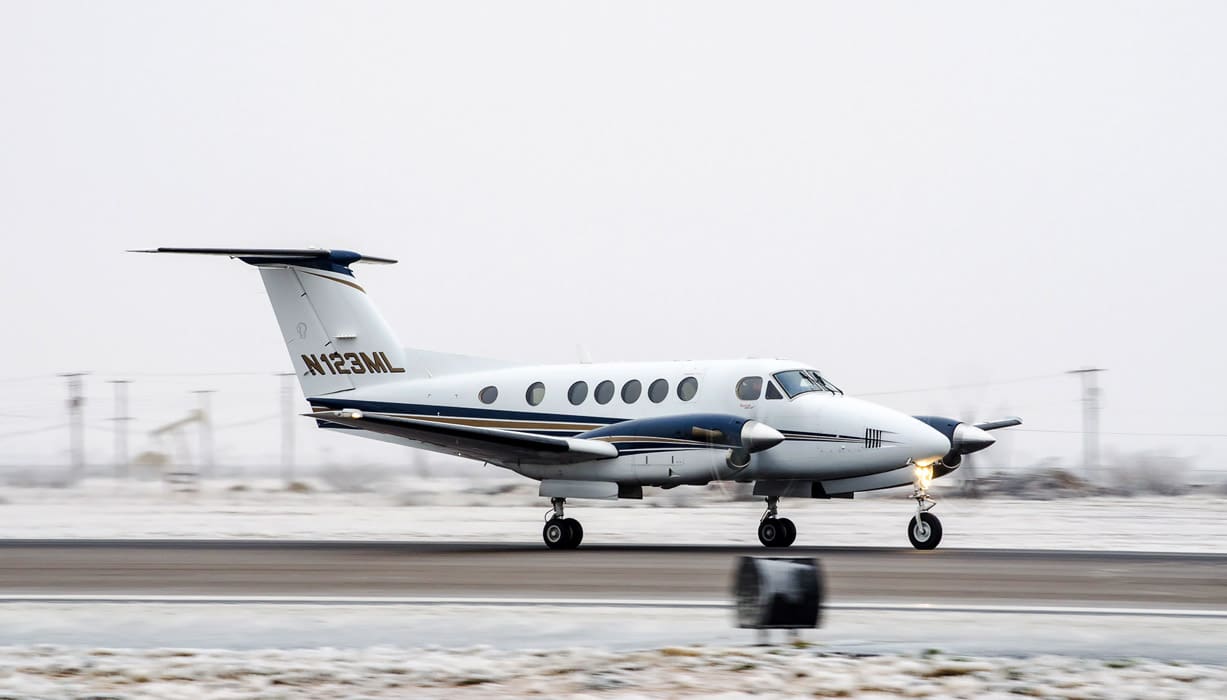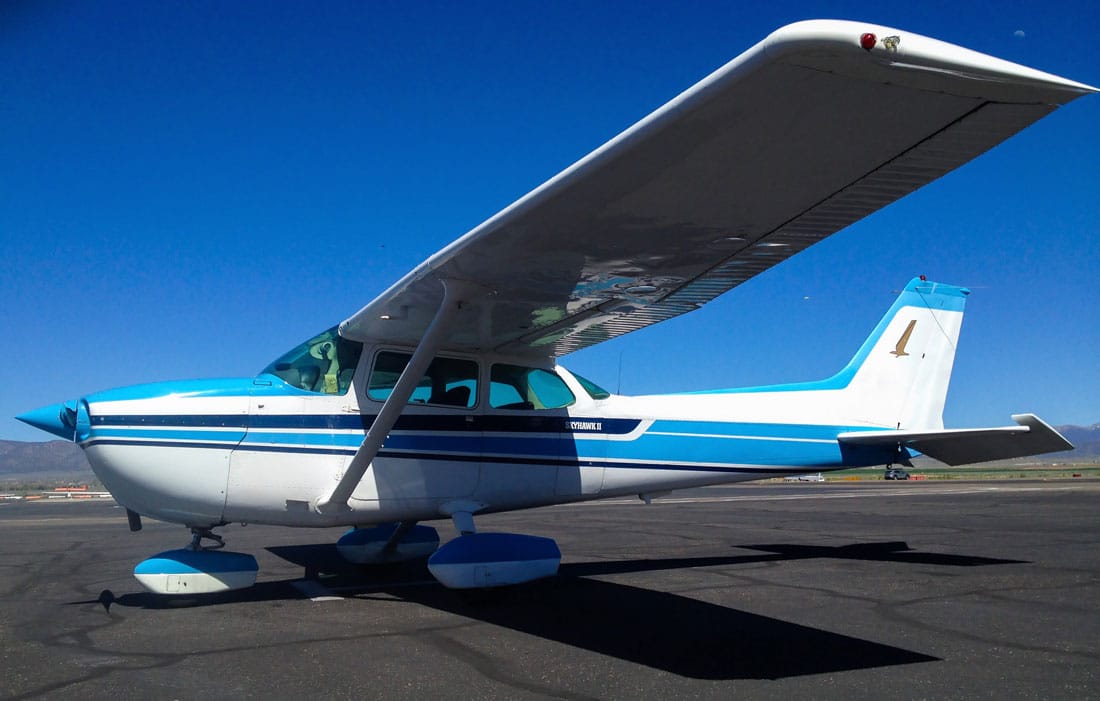When confronted with contaminated runways, all those aircraft performance calculations can dissolve quickly.
Sitting next to me right now is a pilot’s operating handbook for a 1978 Cessna 172N Skyhawk. Aircraft manufactured prior to 1979 were required to carry only a pilot’s operating handbook (POH). However, after 1979, the FAA required that they must also have an approved airplane flight manual (AFM).1
Light airplanes are manufactured and certified under FAA Part 23 regulations. Large transport type aircraft must adhere to FAA Part 25 regulations. Until 1979, Part 23 airplanes weighing less than 6,000 pounds were not required to have an AFM and only those weighing greater than 6,000 pounds did. However, in 1979, Part 23 was amended and now all must have an AFM. Part 25 airplanes always were required to have an AFM.2
But this discussion is not for the purpose of spouting the virtues of nor criticizing POHs and AFMs. Both manuals have important information in them. This article is not about what is found in the POH and AFM but, instead, what is not.
If I turn to the performance section of the POH (or AFM if there is one) there are tables for calculating how much runway is needed for take off and for landing. For purposes of this example I am going to use the “worst case scenario” provided by the charts in the 1978 Cessna 172N POH; high, hot and fully loaded…airport pressure altitude elevation 8,000 feet, 104o F and 2,300 pounds.
In this example, our sweaty, bloated Cessna Skyhawk will need 2,095 feet of runway to take off and 760 feet to land. So you merrily tuck those figures into the back of your mind and figure they are your airplane’s maximums. But wait! What’s this tiny font of type say that is found next to the tables? It says, “paved level dry runway, zero wind” and the take-off table specifies throttle to full power before brake release and the landing table mandates “maximum braking effort.”
These are both commonly used techniques but is this the way you routinely fly? Do your passengers enjoy the noise and jerking vibration from full power as their heads whip backward at brake release? Do they enjoy it as much as when you touch down, “chomp on the binders” and their seat belts dig into their colons? Hot dog show-offs use these piloting techniques more often than most of us who resort to them only on an “as needed” basis.
Let’s go back to our “worst case scenario” numbers, 2,095 and 760 feet. What happens when a rain squall swooshes over the airport and drops “liquid sunshine” on the runway? For one thing, it often brings earthworms out of the ground and onto the pavement. For another, it renders those numbers for take off and landing useless. When the runway changes from “dry” to anything else it becomes contaminated and those performance figures might as well be the numbers on your last lottery ticket that didn’t win anything. Fortunately, most operations don’t come anywhere near needing these numbers and the bulk of the C-172N POH runway requirements indicate take off distances of 1,100 feet and landing distances around 650 feet.
The Definition of Contaminated Runways
A runway is considered contaminated any time its square footage is 25% (or more) covered by slush, standing water, snow covered, ice or compacted snow.3 This minimum 25% factor means total, not necessarily continuous. If you’re using a runway with a puddle here and a puddle there and when the puddles are all added up it amounts to 25% or more of the runway, it’s a contaminated runway.
The European Joint Aviation Authorities and the FAA define a dry runway as “one which is neither wet nor contaminated, and includes those paved runways which have been specially prepared with grooves or porous pavement and maintained to retain ‘effectively dry’ braking action even when moisture is present.”

The presence of water on the runway does not necessarily constitute a wet runway. The JAA further breaks the “degree of wetness” down and has a classification called “damp runway.” A damp runway is one in which the surface “is not dry but (contains) moisture (which) does not give it a shiny appearance.”3
The FAA says that a runway becomes contaminated “whenever standing water, ice, snow, slush, frost in any form, heavy rubber, or other substances are present.” Such an interpretation suggests that a “damp” runway is not a “wet” runway. Furthermore the JAA feels that a “wet” runway isn’t necessarily a “contaminated” runway when “the runway surface is covered with water, or equivalent, less than specified [for a contaminated runway] or when there is sufficient moisture on the runway surface to cause it to appear reflective, but without significant areas of standing water.” Huh? I’m getting a headache.
Thanks to super-heroes like Superman, Wonder Woman, and the ICAO, we can find clarity in life. The ICAO cuts through the ambiguity by defining contaminated runways as ones with “Surface water more than 0.125 inch deep, or by slush or loose snow, equivalent to more than 0.125 in of water; snow which has been compressed into a solid mass which resists further compression and will hold together or break into lumps if picked up (compacted snow); or, ice, including wet ice.”4 The FAA throws some additional debris on the contaminated runway situation by adding “frost in any form, heavy rubber, or other substances are present.” Heavy rubber? Yep. Take a look, especially in the touchdown zone of any long runway at the primary airport within class B airspace; it has that artsy zebra decor.
“So if my POH stipulates a dry runway what good are those numbers when the runway is contaminated,” you ask? They’re not. All bets are off. You’re a test pilot when the runway is contaminated.
Performance Data For Contaminated Runways
Larger aircraft such as those certified under FAA Part 25 very often have performance data that is available for some contaminated runway conditions. What makes it a little difficult is that the data provided for those airplanes in addition to the skeletal dry runway data that you have for your Part 23 airplane is predicated on standardized conditions. We’re talking here about a “just off the assembly line” new airplane with fresh brakes, fresh tires, fresh engine(s), tire inflation within a gnat’s whisker of the tire’s design pressure et cetera, et cetera. Take a look at the certification criteria for either FAA Parts 23 or 25 and you will see that they are very specific.
So even using those dry runway figures you might have to use some imagination to equate them to that ratty, wheezing, old 38-year old Cessna 172N. If the aircraft manufacturer doesn’t provide the data (companies like Boeing do) very often commercial operators contract aircraft performance companies like Aerodata (Arizona) or APG (Colorado) to calculate enhanced performance data for their aircraft. Such companies possess a sufficient quantity of algorithms, slide rules, and engineers who paid attention when they were in school to create reliable data for contaminated runways.
One such airplane that does have contaminated runway data is the Cessna 650 Citation turbojet. To illustrate what contaminants do to those dry runway figures this airplane requires a runway length 30% more when the runway is wet. If the runway has between 0.01 to 0.4-inch of standing water or slush the dry runway takeoff distance must be increased by 130%. Loose dry snow requires an additional 150% of the dry runway length. Uh-oh…ice! For ice they simply state UNKNOWN. Conversely, when landing this airplane on a wet runway the dry runway length should be increased by 40%. Up to 0.4-inch of water requires a runway length 125% greater. Loose dry snow increases the dry runway length 145%. Ice is shown as requiring 140% additional runway.
A special word of caution should be mentioned here about ice. I have seen some aircraft manuals that stipulate landing on icy covered runways increases the non-contaminated runway length by up to 200%. Before landing on any contaminated runway a pilot should always attempt to obtain braking action reports. If an aircraft has landed and reports braking action as “nil,” don’t even attempt it. Also, it is important to be mindful of what type of aircraft and systems were available on the airplane giving the braking action report. If the report came from a jet or turboprop it also has things you may not have on your airplane like thrust reversers, drag inducing lift dumpers on the wings, anti-skid systems on the wheels or the beta range on turbopropeller engines.
Another gem of concern on contaminated runways is hydroplaning, which is where the rotating tire loses traction and rides a “wave” of fluid somewhat like a surfboard does on water. The speed at which you hydroplane is easily computed: Square root of the tire pressure times 9. Above that number, you may hydroplane if the fluid dynamics are right. So if your tire pressure on the nose is 45 PSI and on the mains, 38 PSI as you accelerate on take off your main tires will begin hydroplaning first (55 knots). By the way, this formula is just like everything else and is a rough guideline and depends on a lot of other factors (of which most involve algebra with lots of Greek symbols).

Although we have been using the Cessna 172N for our examples, pilots of single-engine airplanes are not usually concerned about accelerate-stop distance like those pilots of twin-engine airplanes; or “balanced field length” like pilots of turbine aircraft. Suffice it to say you should plan every take off with two things in mind: Losing an engine on the runway and being able to land if you must return immediately due to an emergency.
For this reason and on a contaminated runway it is very important to make sure you have enough runway for your takeoff (in our Cessna 172N example) 2095 feet, plus 760 feet should you have to abort the take off and need to bring the airplane to a stop. Suddenly operating that 172N out of an 1,800-foot strip doesn’t look so good, does it?. The situation is worsened by contaminants that can increase the necessary runway by as much as 30 to 150%.
What Should You Do About Contaminated Runways?
All of the factors and numbers I have used here are for illustration only and, obviously, should not be used for actual computation of performance. Now that I’ve wiggled out of that sticky spot, what am I advocating you do about contaminated runway operations? First, don’t be afraid to request, nor allow controllers or other aircraft to intimidate you, from asking for the longest runway available. Even if it delays you, you might be glad for the added breathing room in front and on each side of you.
Carefully scrutinize all your POH and/or AFM performance data for qualifiers and restrictions. “Dry runway, paved, zero wind” means just that and no more.
If you must use a runway that is contaminated, request braking action reports from other airplanes or the controller. If you are flying a Beech Baron, obviously a braking action report from another Baron is probably more accurate than one from a Boeing 737 or an airport vehicle.
On the start of the take off roll or after you have fully stalled during landing, you may wish to apply forward pressure to the yoke to increase downward force and create more friction with the pavement to help slow you down. In some T-tailed aircraft, this is not advisable, however as it can cause the downwardly- deflected elevator to actually create lift and lessen the main’s footprint on the pavement and friction. Check with your instructor on the best technique for the airplane you fly.
Avoid “grease job” landings on contaminated runways. You want the tire to make a firm contact to disperse as much of the contaminants out of the way as possible and allow the tires to have full effectiveness for friction, drag, and deceleration.
At best, additives to runway performance are only educated guesses anyway. NASA, in conjunction with Transport Canada and the FAA, conducted a five-year study called Joint Winter Runway Friction Measurement Program.5 Through my position at the time involved in standards for an airline in 2000, I became acquainted with its program manager who supplied me with data that was surprising. NASA’s exhausting studies revealed performance data metrics were like trying to hit a moving target because of the many dynamics involved. Friction coefficients can change a great deal when you start changing even the smallest parameter.
I learned that when you deviate from that standard dry level runway modeling the additives are only a “best guess.” To complicate it further the additives aren’t necessarily always one single figure like with such-and- such conditions you need to increase your runway distance by 18%. Instead the additives are in a range meaning they may be applicable, for instance, anywhere from 14 to 21% So at some airports you can take off easily if you apply the 14% figure but if the 21% figure is applicable because of specific conditions on that day, the takeoff can not be made. So how do you know? You don’t really.

FAA Works to Improve Reporting on Runway Conditions
Of course, we’re talking about extreme conditions here and the NASA tests were with aircraft that require lots of real estate, even under the best of conditions anyway. The point I am driving home here is to take nothing for granted and assume no absolutes. When you are taking off or landing from contaminated runways, choose one that is long and wide and leave the hot-dog flying out of tight runways to days when the runway is dry and pressure altitude, temperature, and performance won’t be a factor.
Featured Image: Loaded Aaron, CC2
Footnotes and References:
1 – The differences between a Pilot’s Operating Handbook (POH) and an Airplane Flight Manual (AFM) are somewhat inconsistent. Simply stated, the POH is generally published with data and information that can be broadly applied to all aircraft of the make and model for which it was written. The AFM contains much of the information found in the POH but generally expands on performance. Because of this, it is usable only for that airplane and will be identified with that airplane’s make, model, and serial number. POHs can be purchased through pilot shops and FBOs; AFMs cannot.
2 – Advisory Circular 60-6B “Airplane Flight Manuals (AFM) Approved Manual Materials, Markings and Placards-Airplanes.” FAA, 9/25/1980.
3 – Approach and Landing Briefing Note 8.5, Flight Safety Digest, Flight Safety Foundation, August-November 2000.
4 – ICAO Manual on Reporting of Surface Runway Conditions
5 – //ntrs.nasa.gov/archive/nasa/casi.ntrs.nasa.gov/19990052866.pdf















Leave a Reply